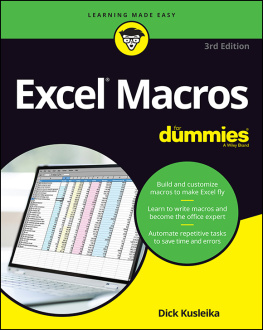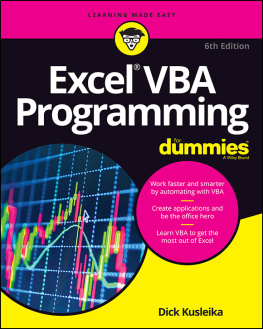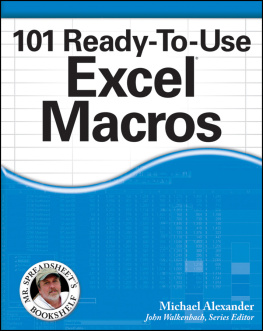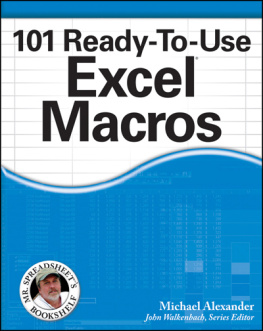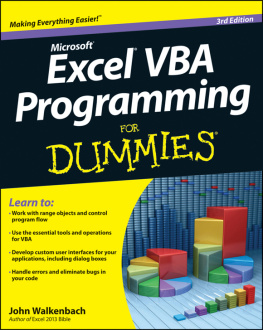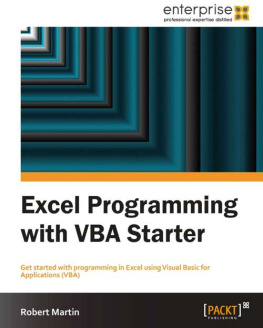Supplemental files and examples for this book can be found at http://examples.oreilly.com/9780596003593/. Please use a standard desktop web browser to access these files, as they may not be accessible from all ereader devices.
All code files or examples referenced in the book will be available online. For physical books that ship with an accompanying disc, whenever possible, weve posted all CD/DVD content. Note that while we provide as much of the media content as we are able via free download, we are sometimes limited by licensing restrictions. Please direct any questions or concerns to .
Preface
As the title suggests, this book is for those who want to learn howto program Microsoft Excel Version 8 (for Office 97) and Version 9(for Office 2000).
We should begin by addressing the question, "Whywould anyone want to program Microsoft Excel?" Theanswer is simple: to get more power out of this formidableapplication. As you will see, there are many things that you can doat the programming level that you cannot do at the user-interfacelevelthat is, with the menus and dialog boxes of Excel. provides some concrete examples of this.
This book provides an introduction to programming the Excel objectmodel using Visual Basic for Applications (VBA). However, it is notintended to be an encyclopedia of Excel programming. The goal here isto acquaint you with the main points of Excelprogrammingenough so that you can continue your education (aswe all do) on your own. The goal is that after reading this book youshould not need to rely on any source other than the Excel VBA Helpfile or a good Excel VBA reference book and a nice object browser(such as my Enhanced Object Browser).
It has been my experience that introductory programming books (and,sadly, most trade computer books) tend to do a great deal ofhandholding. They cover concepts at a very slow pace by padding themheavily with overblown examples and irrelevant anecdotes that onlythe author could conceivably find amusing, making it difficult toferret out the facts. Frankly, I find such unprofessionalismincredibly infuriating. In my opinion, it does the reader a greatdisservice to take perhaps 400 pages of information and pad it withanother 600 pages of junk.
There is no doubt in my mind that we need more professionalism fromour authors, but it is not easy to find writers who have both theknowledge to write about a subject and the training (or talent) to doso in a pedagogical manner. (I should hasten to add that there are anumber of excellent authors in this areait'sjust that there are not nearly enough of them.) Moreover, publisherstend to encourage the creation of 1000-plus page tomes because of thegeneral feeling among the publishers that a book must be physicallywide enough to stand out on the bookshelf! I shudder to think thatthis might, in fact, be true. (I am happy to say thatO'Reilly has not succumbed to this opinion.)
By contrast, Writing Excel Macros with VBA isnot a book in which you will find much handholding (nor will you findmuch handholding in any of my books). The book proceeds at arelatively rapid pace from a general introduction to programmingthrough an examination of the Visual Basic for Applicationsprogramming language to an overview of the Excel object model. Giventhe enormity of the subject, not everything is covered, nor should itbe. Nevertheless, the essentials of both the VBA language and theExcel object model are covered so that, when you have finished thebook, you will know enough about Excel VBA to begin creatingeffective working programs.
I have tried to put my experience as a professor (about 20 years) andmy experience writing books (about 30 of them) to work here to createa true learning tool for my readers. Hopefully, this is a book thatcan be read, perhaps more than once, and can also serve as a usefulreference.
Preface to the Second Edition
With the recent release of Excel 10 (also called Excel XP), it wasnecessary to update my book. Excel XP is mostly an evolutionary stepforward from Excel 2000, but does have some interesting new featuresworth special attention, such as support for text-to-speech and smarttags.
The Excel object model has 37 new objects, containing 266 newmembers. There are also 180 new members of preexisting objects. Inthis book, I cover most of the central objects..)
Figure P-1. New objects in the Excel XP object hierarchy
The Book's Audience
As an introduction to programming in Excel VBA, the book is primarilyaddressed to two groups of readers:
Excel users who are not programmers but who would like to be. If youfall into this category, it is probably because you have begun toappreciate the power of Excel and want to take advantage of its moreadvanced features or just accomplish certain tasks more easily.
Excel users who are programmers (in virtually anylanguageVisual Basic, Visual Basic for Applications, BASIC, C,C++, and so on) but who are not familiar with the Excel object model.In this case, you can use Writing Excel Macrosto brush up on some of the details of the VBA language and learnabout the Excel object model and how to program it.
Organization of This Book
Writing Excel Macros consists of 21 chaptersthat can informally be divided into four parts (excluding theintroductory chapter). In addition, there are five appendixes.
introduces programming and the Visual Basic for Applicationslanguage.
examine theVisual Basic Integrated Development Environment (IDE), which is theprogramming environment used to develop Excel VBA applications.
The second part of the book consists of ).
The third part of the book is devoted to some general topics that areneeded to create usable examples of Excel applications and to theExcel object model itself. We begin with a discussion of objectmodels in general (). (Those who have read my bookLearning Word Programming might notice thatthese topics came at the end of that book. While I would havepreferred this organization here as well, I could not constructmeaningful Excel examples without covering this material before discussing the Excel object model.)
The last chapters of the book are devoted to the Excel object modelitself. This model determines which elements of Excel (workbooks,worksheets, charts, cells, and so on) are accessible through code andhow they can be controlled programmatically. covers SmartTags. I have tried to include useful examples at the end of most ofthese chapters.
The appendixes provide a diverse collection of supplementarymaterial, including a discussion of the Shape object, which can beused to add some interesting artwork to Excel sheets, determiningwhat printers are available on a user's system (thisis not quite as easy as you might think), and how to program Excelfrom other applications (such as Word, Access, or PowerPoint). Thereis also an appendix containing a very brief overview of programminglanguages that is designed to give you a perspective on where VBAfits into the great scheme of things.


